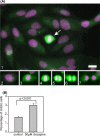Tubulin/microtubules as novel clozapine targets
- PMID: 34964309
- PMCID: PMC8919115
- DOI: 10.1002/npr2.12221
Tubulin/microtubules as novel clozapine targets
Abstract
Aim: Clozapine is currently the only effective drug for treatment-resistant schizophrenia; nonetheless, its pharmacological mechanism remains unclear, and its administration is limited because of severe adverse effects. By comparing the binding proteins of clozapine and its derivative olanzapine, which is safer but less effective than clozapine, we attempted to clarify the mechanism of action specific to clozapine.
Methods: First, using the polyproline rod conjugates attached with clozapine or olanzapine, clozapine-binding proteins in extracts from the cerebra of 7-week-old ICR mice were isolated and separated by sodium dodecyl sulfate-polyacrylamide gel electrophoresis (SDS-PAGE) and analyzed by liquid chromatography-tandem mass spectrometry (LC-MS/MS) to identify proteins. Second, the effect of clozapine on tubulin polymerization was determined turbidimetrically. Finally, the cellular effects of clozapine were observed in HeLa cells by immunofluorescence microscopy.
Results: Alpha and β tubulins were the most abundant clozapine-binding proteins. We also found that clozapine directly binds with α and β tubulin heterodimers to inhibit their polymerization to form microtubules and disturbs the microtubule network, causing mitotic arrest in HeLa cells.
Conclusion: These results suggest that α and β tubulin heterodimers are targeted by the clozapine and the microtubules are involved in the etiology of schizophrenia.
Keywords: clozapine; microtubule; olanzapine; schizophrenia; tubulin.
© 2021 The Authors. Neuropsychopharmacology Reports published by John Wiley & Sons Australia, Ltd on behalf of The Japanese Society of Neuropsychopharmacology.
Conflict of interest statement
All authors declare that they did not receive financial or other support from organizations that may be interested in the work submitted. There are no other relationships or activities that may have influenced the submitted work.
Figures




References
-
- Kohlrausch FB. Pharmacogenetics in schizophrenia: a review of clozapine studies. Braz J Psychiatry. 2013;35(3):305–17. - PubMed
-
- Siskind D, McCartney L, Goldschlager R, Kisely S. Clozapine v. first‐ and second‐generation antipsychotics in treatment‐refractory schizophrenia: systematic review and meta‐analysis. Br J Psychiatry. 2016;209(5):385–92. - PubMed
-
- Millan MJ, Fone K, Steckler T, Horan WP. Negative symptoms of schizophrenia: clinical characteristics, pathophysiological substrates, experimental models and prospects for improved treatment. Eur Neuropsychopharmacol. 2014;24(5):645–92. - PubMed
-
- Young SL, Taylor M, Lawrie SM. "First do no harm." A systematic review of the prevalence and management of antipsychotic adverse effects. J Psychopharmacol. 2015;29(4):353–62. - PubMed
-
- Oyewumi LK, Al‐Semaan Y. Olanzapine: safe during clozapine‐induced agranulocytosis. J Clin Psychopharmacol. 2000;20(2):279–81. - PubMed
Publication types
MeSH terms
Substances
LinkOut - more resources
Full Text Sources

